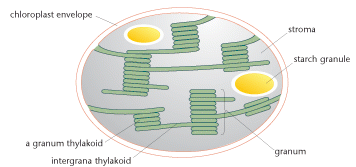Autotrophic nutrition
Different types of autotrophic nutrition
Autotrophic nutrition is very important! Autotrophic nutrition means that simple inorganic substances are taken in and used to synthesise organic molecules. Energy is needed to achieve this. In photo-autotrophic nutrition light is the energy source. In most instances the light source is solar energy, the process being photosynthesis. Carbon dioxide and water are taken in by organisms and used to synthesise glucose, which can be broken down later during respiration to release the energy needed for life. By far the greatest energy supply to support food chains and webs is obtained from photo-autotrophic nutrition. Most producers use this nutritional method.
Chemo-autotrophic nutrition can also supply energy needs to some organisms. Simple inorganic substances are taken in and synthesised into organic molecules.
Chemical energy is the source for this process.
Here are two examples of chemo-autotrophs:
Nitrosomonas
bacteria
ammonia + oxygen = nitrite + water + energy
Nitrobacter
bacteria
nitrite + oxygen = nitrate + energy
The energy released in each of the above reactions is the result of the oxidation of inorganic substances. During respiration it is organic chemicals which are oxidised.
The sulphur bacteria oxidise sulphur and release energy.
Thiobacillus
bacteria
sulphur + oxygen = sulphate + energy
Imagine these organisms in an underground cave, with the ability to support a complete food web without the need for light. Remarkable!
The Chloroplast
Chloroplasts are organelles in plant cells which photosynthesise. In a leaf they are strategically positioned to harvest the maximum amount of light energy. Most are located in the palisade mesophyll of leaves but they are also found in both spongy mesophyll and guard cells. There is a greater amount of light entering the upper surface of a leaf so the palisade tissues benefit from a greater chloroplast density.
The diagram below shows the structure of a chloroplast.

Structure and function
A system of thylakoid membranes is located throughout the chloroplast. These are flattened membranous vesicles which are surrounded by a liquid based matrix, the stroma.
Along the thylakoid membranes are key substances:
- chlorophyll molecules
- other pigments
- enzymes
- electron acceptor proteins.
Throughout the chloroplasts, circular thylakoid membranes stack on top of each other to form grana. Grana are linked by longer intergrana thylakoids. Grana thylakoids and intergrana thylakoids have different pigments and proteins. Each type has a different role in photosynthesis!
The key substances in the thylakoids occur in specific groups comprising of pigment, enzyme and electron acceptor proteins. There are two specific groups known as photosystem I and photosystem II.
The photosystems
Each photosystem contains a large number of chlorophyll molecules. As light energy is received at the chlorophyll, electrons from the chlorophyll are boosted to a higher level and energy is passed to pigment molecules known as the reaction centre.
Key Point
The reaction centre of photosystem I absorbs energy of wavelength 700 nanometres. The reaction centre of photosystem II absorbs energy of wavelength 680–690 nanometres. In this way light of different wavelengths can be harvested.
